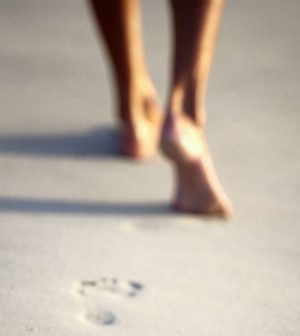- Skip Storing This Everyday Product in the Fridge Door
- Green Tea + B3 Pairing May Boost Brain Health
- Navigating Your Midlife Crisis: Embracing New Possibilities
- City Raccoons Showing Signs of Domestication
- Mapping the Exposome: Science Broadens Focus to Environmental Disease Triggers
- One Week Less on Social Media Linked to Better Mental Health
- Your Brain Changes in Stages as You Age, Study Finds
- Some Suicide Victims Show No Typical Warning Signs, Study Finds
- ByHeart Formula Faces Lawsuits After Babies Sickened With Botulism
- Switch to Vegan Diet Could Cut Your Greenhouse Gas Emissions in Half
Plasma Injection Therapy May Be Useless Against Achilles Tendon Pain

A treatment commonly used to tackle an often painful Achilles tendon condition doesn’t actually work, British researchers warn.
At issue is “Achilles tendinopathy,” a degenerative wear-and-tear disease that affects the critical tissue linking calf muscles to the heel.
Patients have sought pain relief with a treatment — embraced by a number of famous athletes — that involves injecting platelet-rich plasma (PRP) directly into the tendon.
Study author Rebecca Kearney explained that this involves taking a patient’s own blood and “spinning it in a centrifuge to separate out the blood components, and then injecting one of the blood components — which contains a high number of platelets that play an important role in the repair processes — into the painful tendon of the participant.”
The problem? Kearney said that after testing the procedure among 240 patients, her team “found no evidence that this injection was any better than a sham injection.”
Kearney is a professor specializing in trauma and orthopedic rehabilitation at the University of Warwick in Coventry, England.
She noted that “pain in the back of the heel affects 150,000 people annually, leading to walking difficulties,” with Achilles tendinopathy being the most common cause.
As for the hype surrounding the plasma treatment, the American Academy of Orthopaedic Surgeons (AAOS) said that high-profile athletes — such as golf legend Tiger Woods and tennis superstar Rafael Nadal — have turned to the treatment to address a range of painful conditions, including tendon injuries and knee sprains.
The reasoning behind using PRP has to do with the abundant platelet component found in centrifuged blood, the AAOS explained.
Platelets are known for their clot-inducing properties, which helps to heal wounds. They also contain growth factor proteins thought to be helpful in injury recovery. When blood is centrifuged, the end result is a higher-than-normal concentration of platelets per liter of blood, AAOS said.
But to see if any of that actually translates into pain relief, the investigators enlisted 121 adult patients (average age 52), all of whom struggled with Achilles tendon pain for at least three months.
All were given a single PRP injection. For comparison, another 119 patients were given a single fake injection during the same time frame.
Both three and six months later, all the patients were assessed for pain levels and their ability to function and remain active.
The result: no appreciable difference was seen between the treatment group and the placebo group.
And the treatment is not entirely benign, the researchers stressed, given that the injection itself was found to cause bleeding, bruising and swelling around the injection site (though all such side effects eventually resolved).
Kearney said the findings suggest that the plasma treatment not be deployed as a means to relieve Achilles pain.
The problem, said Kearney, is that there is no single trigger for Achilles tendinopathy, making it difficult to develop a broadly effective therapy.
“This remains a difficult condition to treat,” she acknowledged, “with many treatments available, and little evidence to guide which to use.”
That lack of a reliable solution is a problem, given that “everyone is vulnerable,” says Dr. Zachary Vaupel, an assistant professor of orthopedic surgery at Oakland University William Beaumont School of Medicine in Rochester, Mich.
On the upside, Vaupel said nonsurgical interventions can prove helpful. “Stretching of the gastrocnemius and Achilles tendons is the mainstay of nonoperative treatment. This can be done with home stretching exercises or through formal physical therapy, and should include eccentric stretching of the Achilles tendon,” he explained. Eccentric stretching refers to tension applied to a muscle as it lengthens.
“This is typically a very effective means of treatment of Achilles tendinopathy, when the stretches are done diligently and correctly,” Vaupel said.
He also said surgery “should be reserved as a last resort, in cases where patients have failed the above-mentioned treatments.”
Kearney and her colleagues published their findings recently in the Journal of the American Medical Association.
More information
There’s more on Achilles tendinopathy at the American Academy of Orthopaedic Surgeons.
SOURCES: Rebecca Kearney, PhD, professor, trauma and orthopedic rehabilitation, and associate director, Warwick Clinical Trials Unit, University of Warwick, Coventry, U.K.; Zachary Vaupel, MD, assistant professor, orthopedic surgery, Oakland University William Beaumont School of Medicine, Rochester, Mich., and orthopedic foot and ankle surgeon, Michigan Orthopaedic Surgeons, Royal Oak, Mich.; Journal of the American Medical Association, July 13, 2021
Source: HealthDay
Copyright © 2025 HealthDay. All rights reserved.










